Socialization is a topic that is frequently talked about, especially in the context of puppies. In the past when I’ve asked clients what they think “socialization” means, I’ve heard answers like “playing with other dogs,” “meeting 100 new people,” or “interacting with new objects.” While these are certainly elements of socialization, I would define “socialization” a bit differently.
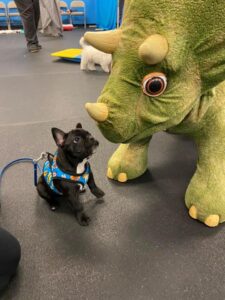
Peggy the French Bulldog learns that the giant bug eyed dino might not be a giant monster.
After lots of going back and forth on the wording, the definition I like for the critical puppy socialization period is “the period starting at 3 weeks and ending between 12 and 16 weeks where puppies are more receptive to building positive associations with novel experiences.” Going from that then, the definition I like for puppy socialization is “the process of teaching a puppy to live and behave in the situations it will encounter throughout its life.”
Huh? That doesn’t say anything about puppy playtime, meeting 100 people, or what to do when your puppy flees in terror from a fire hydrant. One thing I love about dogs is how incredibly diverse they are – some dogs are housepets, others detect bombs or narcotics, and others are olympian-style athletes flying through obstacle courses at mach speeds. This incredible species we share our lives with can range from 2 lbs to 200 lbs or more! With this much variance in size, shape, behavior, and goals, why would it make sense for there to only be one “correct” type of socialization plan?
When developing a socialization plan for your puppy, make a list of your goals, aka what you want to be able to do with the dog over the course of his life. Are you an avid hiker? Put hiking areas on your list. Do you like eating on the patios of dog-friendly restaurants? Coffee shop patios are an excellent start for this. Do you want your dog to be friendly around kids? Recruit some friends with kids (or ask in local Facebook pages/nextdoor if anyone has kids who want to meet a puppy). Do you want your dog to have laser focus on you around other dogs? Set up a blanket 20-100 ft away from an area like a dog park (but please don’t take young puppies inside) and work on focus games. Remember though – this plan is all about YOUR goals.
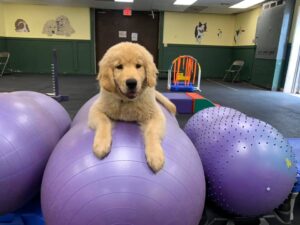
Chester the Golden Retriever confidently lays on a balance peanut.
Next big question… when should socialization begin? In my definition of the critical puppy socialization period I mentioned that the window starts at 3 weeks and closes at 12-16 weeks. However, most puppies aren’t finished with shots until 16 weeks, and it’s commonly advised to not take puppies out until they’re done with shots.
While there is absolutely truth to the risk of parvovirus, adenovirus, distemper, and parainfluenza (among other illnesses), socialization is just as critically important. For humans, the “childhood vaccines” aren’t typically completed until around 6 years old. I don’t know of anyone who would advise keeping kids locked in the house and away from potential risk until that time, nor do I think that it would be beneficial for childhood development. Why then should we treat puppies differently? (Answer: we shouldn’t!) Be prudent though, since the illnesses that most commonly affect puppies are transmitted through infected feces, avoid areas with heavy dog traffic where vaccines aren’t required, such as dog parks, very busy trails, and pet stores. The American Veterinary Society for Animal Behavior has a wonderful position statement weighing the risks of socializing vs not socializing before vaccines are completed, if you would like to read further you can do so here: https://avsab.org/wp-content/uploads/2018/03/Puppy_Socialization_Position_Statement_Download_-_10-3-14.pdf
Whatever you are working on “socializing” your puppy to, remember: this period is about building positive experiences with things we want them to feel comfortable with as adults. If your puppy is feeling nervous of a baby stroller, don’t drag him up to it. You can toss treats for offered interaction with items and people, but toss them AWAY from the thing. This basically acts like a “reset” and allows the puppy a choice: does he want to check that thing out again (maybe a little closer this time), or does he prefer to observe from a safe distance? Choice breeds empowerment, empowerment breeds confidence. We want confident puppies!
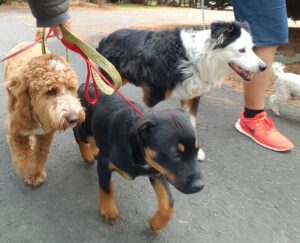
Puppy Uli learns to calmly go with the flow when other dogs are around rather than harassing them to play.
With socialization to other dogs, there is a lot more variance on types of interaction. Do you want a “dog park dog” who can basically play with anyone that comes his way? Then a well-run puppy socialization play group at a professional training facility may be a great option for you. Do you want a sport dog who will barely flick an ear towards a passing dog? Focusing more on engagement, play, and relationship building in environments where other dogs are near but not available is a great choice then. Do you want something in between? Mix and match! Appropriate adult dog role models are also worth their weight in gold here – if you can find an adult dog who plays appropriately with puppies but will engage with their handler at the drop of a hat when asked, then absolutely let your puppy learn socially from that dog.
With building confidence and excitement towards the world or towards us, our puppies can tip into the “danger zone” of overarousal. Overarousal is where our puppy’s brain starts to go a million miles an hour in every direction (a more scientific definition is “a physiologically aroused state characterized by heightened, overexcited reactions.”) I see this overarousal occurring most frequently in chaotic puppy play groups, but it can really happen in any environment (especially if your puppy is a bit overtired or starting to get to the end of their “thinking brain”). If you notice your puppy starting to become frantic (barking, jumping up, nipping, getting the zoomies, panting, pupils dilating, etc.), it may be time to take a step back, find a quieter area, and do something to calm them down. (It’s cute now when 10 lb Buster is jumping up and licking strangers, but it will be less so when he’s 80 lbs and/or covered in mud!) Good examples of ways to calm down an overaroused puppy could be scattering some treats for them to eat off the ground (or in a snuffle mat), working on impulse control games, or even just walking around somewhere further away from where the excitement was happening. If you want to read more specifically on overarousal in dogs, this is an excellent article on it: https://www.whole-dog-journal.com/behavior/training-an-over-aroused-dog/
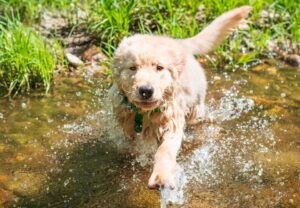
Golden Retrievers like Chester are going to be more naturally inclined to love water than some other breeds.
I would be remiss if I wrote a post on socialization and didn’t mention genetics. When selecting and raising a puppy, I follow the rule of “before you get the puppy, assume all behavior will be genetic. After you get the puppy, assume all behavior will be environmental.” A border collie is going to be able to herd sheep with much more proficiency at 8 weeks than an 8 week old Basset Hound. An 8 week old Labrador Retriever will retrieve duck wings much more reliably than an 8 week old English Mastiff. This doesn’t just apply to dog “jobs,” it also applies to things like friendliness/aggression towards people and dogs, confidence/nervousness, independence/velcro-ness, and more. Before bringing your puppy home, do lots of research into breed (or if you’re getting a rescue puppy, into guessed breeds). Even within breeds there can be a lot of variance, so be sure to choose your breeder carefully. I will write a post in the future on how to find a good breeder, so stay tuned for that!
All in all, socialization is a very personal process. You are not just shaping your dog to live in the human world, you are shaping him to live in YOUR world. It’s important to me that my dogs are confident and comfortable in sport situations as I do have many competition goals for them, but I live with them too so it’s equally (or more, sometimes) important that they can settle in the house, be polite on a hiking trail, and work as demo or decoy dogs for my clients. What are your goals for your dog, and what type of dog do you want to build?
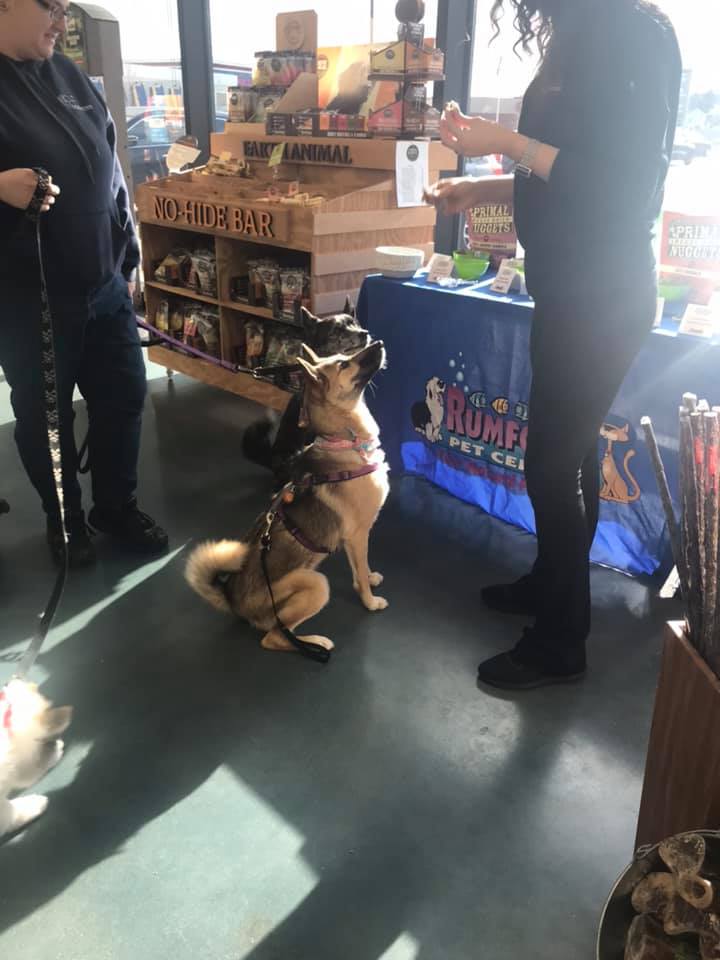
Raven the West Siberian Laika learns that sitting politely for strangers earns treats and attention.
These are not comprehensive lists by any means, but some “example lists” of socialization experiences to start with are listed below:
Sport dog socialization ideas:
- Crating in areas with lots of foot traffic (bring a crate to a park/outside a store!)
- Tugging and eating food in a variety of areas
- Walking on wobble boards and unstable surfaces
- Passing “unavailable” dogs (x-pens make great barriers for this)
- Loud, echoing noises (parking garages and hardware stores are full of these)
- Interesting smells (go to a friend’s yard with high value treats and reward heavily for engagement on you vs the environment)
Pet/companion dog socialization ideas:
- Friends/family coming to visit your house
- Coffee shop patios
- Dog-friendly shops (Home Depot, Lowes, Bed Bath and Beyond, etc. Always call ahead to confirm whether your store’s location is dog friendly first)
- Walking around the neighborhood or in downtown areas
- Getting groomed/handled by both family and strangers
- Children being calm and being active
- People wearing strange clothing or costumes
- Running appliances (blender, vacuum, lawnmower, etc.) while your puppy works on a tasty Kong
Working dog socialization ideas:
- Being appropriate near livestock
- Sounds of heavy machinery
- Vehicle traffic (trucks, cars, ATVs)
- Wearing different types of gear (boots, vests, goggles)

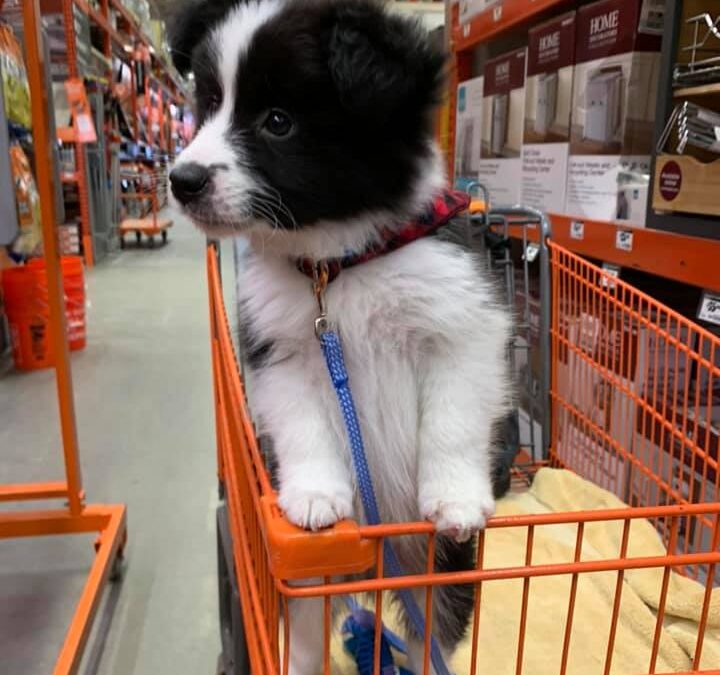
Recent Comments